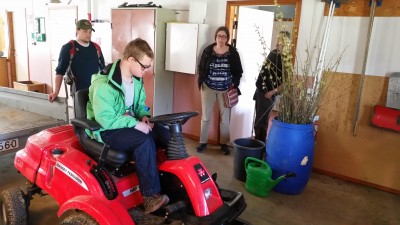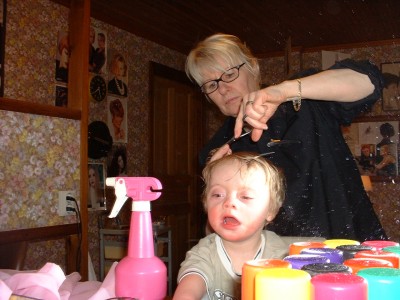Det finns mycket forskning om inkludering. Just den här listan är sammansatt av den amerikanska organisationen: The National Catholic Board on Full Inclusion. Jag har inte faktagranskat detta!
Affleck, Madge, Adams, & Lowenbraun (1988). Integrated classroom versus resource model: Academic viability and effectiveness. Exceptional Children, 57, 339-348.
This study spanned 15 years and found that students with disabilities educated in inclusive settings had an employment rate of 73% while those in segregated programs had an employment rate of 53%.
Baker, Wang, & Walberg (1994). The effects of inclusion on learning. Educational leadership, 52, 33-35.
This study showed that students with ID educated in regular classes do better academically and socially than comparable students in non-inclusive settings.
Brandt (2011). From Policy to practice in higher education: The experiences of disabled students in Norway. International Journal of Disability, Development, and Education, 58, 107-120.
This study is based on qualitative data from in-depth interviews with disabled students in higher education. The findings indicate that an educational reform in Norwegian higher education seems to have helped to strengthen disabled students’ potential for learning, but there are a number of critical periods during their studies when it is imperative for disabled students to get the adjustment needed.
Buckley, Bird, & Sacks (2006). Evidence that we can change the profile from a study of inclusive education. Down Syndrome Research and Practice, 9, 51-53.
This paper discusses the evidence that the specific developmental profile frequently described as being associated with Down syndrome – a profile of communication weaknesses relative to social and daily living skills – can be changed. It is not an inevitable outcome of having Down syndrome. Drawing on data collected to explore the outcomes of fully inclusive education for school-age children with Down syndrome, the authors identify that the profile is seen in teenagers in special education settings but is not evident for teenagers in inclusive education. They argue that this is the result of both the effects of fully inclusive education and teaching approaches which have been adapted to address the cognitive and communication weaknesses of the children from an early age.
Buckley, Bird, Sacks, & Archer (2006). A comparison of mainstream and special education for teenagers with Down syndrome: Implications for parents and teachers. Down Syndrome Research and Practice, 9, 54-76.
This article presents data from a research study designed to compare the achievements of teenagers with Down syndrome educated in mainstream classrooms or in special education classrooms throughout their full-time education. Progress is reported for speech and language, literacy, socialisation, daily living skills and behaviour. For all the teenagers, there is evidence of progress with age on all the measures except for communication. Communication continued to improve through teenage years for the included children but not for those in special education classrooms. There were no significant differences in overall outcomes for daily living skills or socialisation. However, there were large significant gains in expressive language and literacy skills for those educated in mainstream classrooms. Teenagers educated in mainstream classrooms showed fewer behavioural difficulties. Further, comparison with data published by these authors in an earlier study, showed no improvements in school achievements in special education over a 13 year period in the UK (1986-1999).
Casale-Giannola & Wilson Kamens (2006). Inclusion at a university: Experiences of a young woman with Down syndrome. Mental Retardation, 44, 344-352.
Inclusive classroom interactions can lead to genuine friendships among students with and without disabilities.
Causton-Theoharis, Ashby, & DeClouette (2009). Relentless optimism: Inclusive postsecondary opportunities for students with significant disabilities. Journal of Postsecondary Education and Disabilities, 22, 88-105.
Inclusive college classes can lead to greater comfort for nondisabled students who interact with students with intellectual disabilities.
Cole, Waldron, & Majd (2004). Academic progress of students across inclusive and traditional settings
Effects of inclusive school settings for students in six Indiana school corporations were investigated. Results reveal that students without disabilities educated in inclusive settings made significantly greater academic progress in mathematics and reading. For students with disabilities, there were no significant differences in reading and math achievement across the comparison groups. However, a review of group means and the percentage of students making comparable or greater than average academic progress when compared to students without disabilities indicates a pattern in favor of inclusive settings. The academic progress of students with specific disability labels, namely, learning disabilities and mild mental handicaps, also supported inclusive education.
Costello, C. (1991). A comparison of student cognitive and social achievement for handicapped and regular education students who are educated in integrated versus a substantially separate classroom. Unpublished doctoral dissertation: UMass.
Study found inclusion enhances non-disabled students’ Learning.
Diamond (2001). Relationships among young children’s ideas, emotional understanding, and social contact with classmates with disabilities. Topics in Early Childhood Special Education, 21, 104-113.
Children who had social contact with classmates with disabilities had significantly higher scores on measures of emotion understanding and acceptance of individuals with disabilities than did children who had contact only with typically developing classmates.
Favazza & Odom (1997). Promoting positive attitudes of kindergarten-age children toward people with disabilities. Exceptional Children, 63, 405-418.
This study examined the effects of contact, books, and discussions on the attitudes of kindergarten-age children toward people with disabilities. Children in the high-contact group participated in a program designed to promote acceptance of people with disabilities; the low-contact group had incidental contact with children with disabilities; the no-contact group had neither direct nor indirect contact with children with disabilities. At pretest, all participants had low levels of acceptance of people with disabilities. At posttest, significant gains in levels of acceptance were found only in the high-contact group. The program appears to be an effective strategy for promoting acceptance of people with disabilities.
Favazza, Phillipsen, & Kuman (2000). Measuring and promoting acceptance of young children with disabilities. Exceptional Children.
The results of two studies are presented: (a) an examination of the reliability of the Acceptance Scale for Kindergartners with a sample of non-Caucasian, low socioeconomic status (SES) children, and (b) the efficacy of an intervention designed to promote acceptance of young children with disabilities with this new sample. Results indicate that the Acceptance Scale for Kindergarten–Revised is reliable and that various components of a special friends intervention yield differential results. Specifically, results indicate that children exposed to individual components of the intervention had short-term gains in acceptance of individuals with disabilities, while children exposed to the whole intervention had short-term and long-term gains in acceptance. Exposure to the whole program is more effective than any of the individual components in producing greater changes in levels of acceptance of young children with disabilities.
Ferguson & Ash (1989). Lessons from life: Personal and parental perspectives on school, childhood, and disability. In D. Bilken, A. ford, & D. Ferguson (Eds.), Disability and Society, pp. 108-140. Chicago: National Society for Education.
This study found that the more time students with disabilities spent in regular classes, the more they achieved as adults in employment and continuing education.
Folk, Yamamoto, & Stodden (2012). Implementing inclusion and collaborative teaming in a model program of postsecondary education for young adults with intellectual disabilities. Journal of Policy and Practice in Intellectual Disabilities, 9, 257-269.
The authors provide a descriptive report of an inclusive college program in the state of Hawai‘i and share preliminary feedback from student participants, agency and institutional partners, and project staff. They found that student participants with ID, who were culturally and linguistically diverse, relished the opportunity to participate in PSE and were motivated by the opportunity to learn, meet new people, and contribute to their families. Interagency partners valued the process and benefits of interagency teaming, with most reporting that participating in collaborative teaming resulted in a shift in their views on inclusion of students with ID in PSE.
Gandhi (2007). Context matters: Exploring relations between inclusion and reading achievement of students without disabilities. International Journal of Disability, Development, and Education, 54, 91-112.
This article examines relations between inclusion-related variables and reading achievement of without disabilities, using a nationally representative dataset of Grade 3 students in the United States (U.S.). Controlling for background variables, inclusion —with few exceptions—appears to make no difference in the reading achievement of nondisabled students.
Griffin, Summer, McMillan, Day, & Hodapp (2012). Attitudes toward including students with intellectual disabilities at college. Journal of Policy and Practice in Intellectual Disabilities, 9, 234-239.
The authors surveyed 256 college students about their attitudes toward students with intellectual disabilities and their inclusion in college classes. Overall, the college students reported positive attitudes. They noted that female students and those with higher comfort levels perceived the abilities of people with intellectual disabilities as higher, thought more benefits were associated with their inclusion, and were more willing to interact with them on campus.
Grigal & Hart (2012). The power of expectations. Journal of Policy and Practice in Intellectual Disabilities, 9, 221-222.
The existence of a special issue of the Journal of Policy and Practice on Intellectual Disabilities focusing on postsecondary education for individuals with intellectual disabilities demonstrates that there are increasing expectations that people with an intellectual disability can and should be given the choice of going to college. And similar to other groups of young people who have gone to college, their path toward college and the outcomes that they seek and achieve from college will vary considerably. As students with an intellectual disability become yet another subgroup of the diverse learners in the higher education landscape, the journey to and through college becomes all the more complex. In this issue, we sought to capture some of the many facets that impact or are impacted by this emerging college student group.
Hamill (2003). Going to college: the experiences of a young woman with Down syndrome. Mental Retardation, 41, 340-353.
Inclusive classroom interactions can lead to genuine friendships among students with and without disabilities.
Helmstetter, Peck, Giangreco (1994). Outcomes of interactions with peers with moderate or severe disabilities: A statewide survey of high school students. Journal of the Association for Persons with Severe Handicaps, 19, 263-276.
A statewide survey of 166 high school students examined the outcomes of interaction with peers with moderate or severe disabilities. They results indicate that integration may offer opportunities for nondisabled students to develop a sense of personal responsibility and an ethic of caring and commitment to others.
Hollowood, Salisbury, Rainforth, & Palombaro (1995). Use of instructional time in classrooms serving students with and without severe disabilities. Exceptional Children, 61, 242-253.
This investigation explored the use of teacher and student time in an inclusive elementary school where students with mild to profound disabilities were enrolled in general education classrooms. Students in each group evidenced comparable levels of engaged time, and students with severe disabilities had no effect on losses of instructional time.
Hunt, Staub, Alwell, & Goetz (1994). Achievement by all students within the context of cooperative learning groups. The Journal of the Association for Persons with Severe Handicaps, 19, 290-301.
In a study of cooperative learning groups, students without disabilities who facilitated interactions of their peers with severe disabilities did not have their level of achievement affected.
Jones & Zach (2012). Creating effective mentoring partnerships for students with intellectual disabilities on campus. Journal of Policy and Practice in Intellectual Disabilities, 9, 270-278.
The study identified several key components for creating and improving effective mentoring partnerships on a university campus. These include (1) providing mentoring orientations and faculty training; (2) developing effective systems for communicating and collaborating across stakeholders; (3) promoting the establishment of co-equal relationships among mentoring partners; (4) maintaining high expectations for students with ID; (5) using mentors as resources to professors and establishing natural supports in the college classroom; (6) encouraging independence; (7) prioritizing fun and socializing; and (8) staying focused on the big picture of inclusion.
Kaskinen-Chapman (1992). Saline area schools and inclusive community concepts. In R. Villa, J. Thousand, W. Stainback, & S. Stainback (eds.), Restructuring for caring and effect education (pp 169-185). Baltimore: Paul H. Brookes.
Study found inclusion enhances non-disabled students’ Learning.
Keefe & VanEtten (1994).
Academic and social outcomes for students with moderate to profound disabilities in integrated settings. Paper presented at the conference of the Association for Persons with Severe Handicaps, Atlanta. For students with severe disabilities, this study found higher levels of “active academic responding” and lower levels of competing behavior in general education settings as compared to segregated settings.
Kelly (1992).
Study found that inclusion yields social and emotional benefits for all students, with self-esteem and attendance improves for some students considered “at risk.”
Lipsky & Gartner (1995). The evaluation of inclusive education programs. NCERI Bulleting, 2(2).
This study reported academic, behavioral and social benefits for students with and without disabilities. It also concluded that students within each of IDEA’s 13 categories of disability, at all levels of severity, have been effectively integrated into general education classrooms. Like the Educational Challenges Inclusion Study by NDSS, this one also reported positive outcomes and high levels of professional fulfillment for teachers.
Martinez, Conroy, & Cerreto (2012). Parent involvement in the transition process of children with intellectual disabilities: The influence of inclusion on parent desires and expectations for postsecondary education. Journal of Policy and Practice in Intellectual Disabilities, 9, 279-288.
We studied parents’ means of accessing information and the impact of K-12 inclusive general education experiences on parents’ desires and expectations for PSE. Key findings indicated that parents did not fully understand the transition process and had a low degree of knowledge and access to information about PSE. The data showed that levels of student inclusion related to parental desire and expectation for PSE and to parental involvement in transition planning activities.
May, C. P. (2012). Inclusion of students with intellectual disabilities enhances openness to diversity on a college campus. Journal of Policy and Practice for Intellectual Disability, 9(4), 240-246.
Thus study showed that when students with ID are included in college classes, the attitudes of the students without ID toward diversity and disability became more positive.
May, C. P., & Pittard, L. (2012). Reflections from the peer mentor experience: Evidence for social and moral growth. Monograph of State of the Science in Postsecondary Education for Students with Intellectual and Developmental Disabilities.
This study showed that mentors who work with college-aged students with disabilities show enhanced social and moral development.
May (2013). An investigation of attitude change in inclusive college classes including young adults with an intellectual disability. Journal of Policy and Practice in Intellectual Disabilities, 9, 240-246.
Nondisabled students enrolled in inclusive college classes showed significantly greater openness to diversity at the end of the semester than nondisabled students enrolled in non-inclusive classes.
Okagaki, Diamond, & Kontos (1998). Correlates of young children’s interactions with classmates with disabilities. Early Childhood Research Quarterly, 13, 67-86.
This study was conducted at an inclusive university-based preschool. Parents’ beliefs and children’s attitudes toward children with disabilities were positively related to the frequency of children’s actual contacts with classmates with disabilities during free play time
Pierce (2013). A healthy, thoughtful, insightful discussion about social inclusion in a postsecondary institution. Dissertation Abstracts.
Five key themes emerged as primary observations of social inclusion at a postsecondary education institution: conflict between the college philosophy of social inclusion and the reality of what is happening in individual classes, conflict between encouraging social inclusion and the reality of departmental requirements for courses and graduation, slow pace at which society accepts individuals with developmental disabilities, varied expectations of the outcome of social inclusion, and comfort level with individuals with developmental disabilities.
Rea, McLaughlin, & Walther-Thomas (2002). Outcomes
for students with learning disabilities in inclusive and pullout programs.
Students served in inclusive classrooms earned higher grades, achieved higher or comparable scores on standardized tests, committed no more behavioral infractions, and attended more days of school than did students taught in pull-out special education classrooms.
Salend & Duhaney (1999). The impact of inclusion on students with and without disabilities and their educators. Remedial & Special Education, 20, 114-126.
This article reviews the literature with respect to inclusion programs and students with and without disabilities and their teachers. The findings of the studies reviewed cited indicate that: (a) the impact of inclusion programs on the academic performance and social development of students with disabilities has been mixed; (b) the placement of students without disabilities in inclusion programs does not appear to interfere with their academic performance and has several social benefits for these students; and (c) teachers’ responses to inclusion programs are complex, are shaped by multiple variables, and change over time.
Sharpe, York-Barr, & Knight (1994). Effects of inclusion on the academic performance of classmates without disabilities: A preliminary study. Remedial & Special Education, 15, 281-287.
An inclusive environment was defined as a general education elementary classroom with members including some who had significant disabilities and who were previously taught in self-contained special education classrooms. This study examined the academic performance differences between 35 general education students educated in an inclusive environment (the inclusion group) and 108 general education students who were not in inclusive environments (the comparison group). Group achievement test scores and report card ratings were used as performance indicators in the academic areas of reading, language arts, mathematics, and the behavioral areas of conduct and effort. The results of the study revealed no statistically significant differences between the two groups for every academic and behavioral measure.
Staub & Peck (1994). What are the outcomes for nondisabled students? Educational Leadership, 52, 36-40.
The effects of inclusion on nondisabled students are discussed. Research has found no deceleration of academic progress for nondisabled students enrolled in inclusive classrooms. One study indicated that the presence of students with severe disabilities had no effect on levels of teacher time allocated to, or engaged with, nondisabled students, and the amount of time lost to interruptions of instruction was not significantly different in inclusive and noninclusive classrooms. Observations of young children in inclusive classrooms suggest that nondisabled students seldom learn undesirable behavior from students with disabilities.
Tapasak and Walther-Thomas (1999). Evaluation of a first-year inclusion program.
Students with and without ID showed increased cognitive competence and social skills in inclusive settings.
Uditsky & Hughson (2012). Inclusive postsecondary education – An evidence-based moral imperative. Journal of Policy and Practice in Intellectual Disabilities, 9, 298-302.
In this article, the authors take the position that the desire for inclusive education and the beliefs and principles of inclusive practices must be the foundation for inclusive postsecondary education (IPSE). The authors hold to the principles of inclusion as the foundation for postsecondary education given the known failure of segregated education to result in positive social and economic outcomes. The authors explore the means of achieving better futures for students with ID through IPSE. This article highlights the findings of 25 years experience across the province of Alberta in implementing 18 IPSE initiatives for young adults with the full range of ID, including those with severe and multiple disabilities, and outlines the challenging behaviors thus strengthening evidence for adopting inclusive practices.
U.S. Department of Education (1997). Nineteenth annual report to Congress on the implementation of IDEA, Washington, DC.
In its report, the DOE noted, “across a number of analyses of post-school results, the message was the same: those who spent more time in regular education experienced better results after high school.
Vaughn, Elbaum, & Schumm (1996). The effects of inclusion on the social functioning of students with learning disabilities.
Students with LD in inclusive settings fare at least as well socially as students in resource room settings.
Vrdoljak, T. (2009). An inclusion model for a Catholic school. Momentum: The Official Journal of the National Catholic Educational Association, 40(4), 48-50.
A summary of the key findings and disseminate the information included in the author’s dissertation to a wider audience consisting of administrators, educators, and staff employed in Catholic schools in the United States.
Vrdoljak, T. (2012). Revisiting an inclusion model for a Catholic school. Momentum: The Official Journal of the National Catholic Educational Association, 43(3), 40-43.
A discussion of the progress made in the inclusion program at the author’s school and changes in faculty concerns as compared with the data collected for the author’s dissertation.
Waldron & McLeskey (1998). The impact of a full-time Inclusive School Program (ISP) on the academic achievement of students with mild and severe learning disabilities.
Students with ID made significantly more progress in reading and comparable progress in math when compared to students with ID educated in resources settings.
Källa: http://www.fullinclusionforcatholicschools.org/research-that-supports-inclusion/



 Jag har svårt att tro att elever som vid 16 års ålder fortfarande kämpar med att lära sig grundfärgerna är på samma undervisningsnivå som en som klarar de flesta kunskapskraven i bild för grundskolans åk 9. Det som verkar lättast att tro är att de inte är på samma nivå – att sonen inte hör hemma på träningsskolenivå – ändå är det den enda delen av (gymnasie)särskolan han är välkommen till. OM experterna säger det så måste jag väl tro på dem, eller?
Jag har svårt att tro att elever som vid 16 års ålder fortfarande kämpar med att lära sig grundfärgerna är på samma undervisningsnivå som en som klarar de flesta kunskapskraven i bild för grundskolans åk 9. Det som verkar lättast att tro är att de inte är på samma nivå – att sonen inte hör hemma på träningsskolenivå – ändå är det den enda delen av (gymnasie)särskolan han är välkommen till. OM experterna säger det så måste jag väl tro på dem, eller?




 Det är viktigt att veta att ALLA med downs syndrom kan tillgodogöra sig grundläggande matematiska kunskaper. Det gäller bara att hitta rätt sätt för den enskilde individen och INTE ge upp!
Det är viktigt att veta att ALLA med downs syndrom kan tillgodogöra sig grundläggande matematiska kunskaper. Det gäller bara att hitta rätt sätt för den enskilde individen och INTE ge upp!
